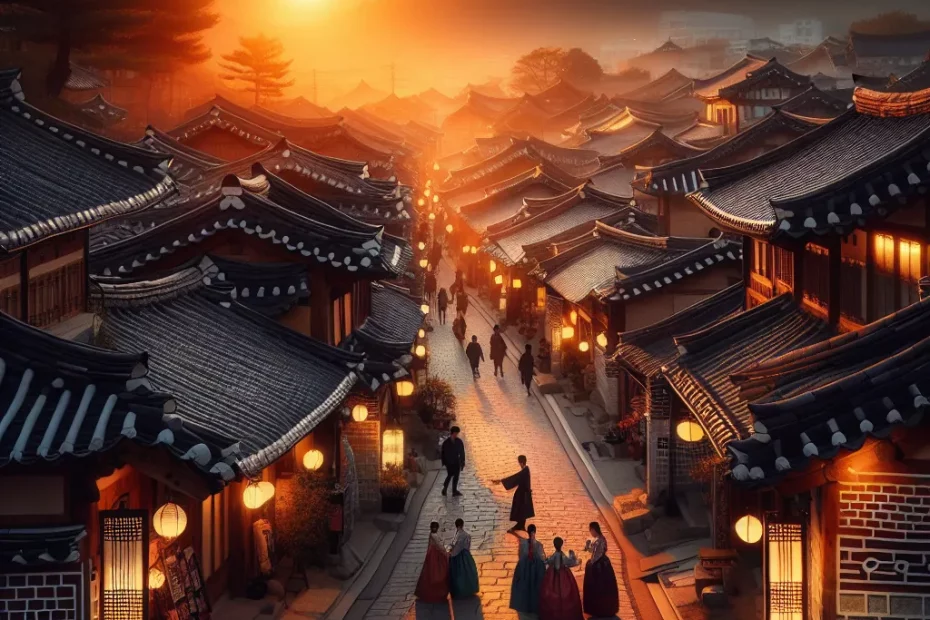Jeonju Hanok Village stands as a testament to the country’s rich cultural heritage and architectural legacy. This historic village, with its well-preserved traditional Korean houses, serves as a living museum, offering visitors a glimpse into Korea’s past. The efforts to maintain and protect this cultural gem not only showcase Korea’s commitment to preserving its traditions but also highlight the importance of cultural heritage in shaping national identity. As we delve into the historical significance of Jeonju Hanok Village, we uncover a tapestry of stories that weave together the past, present, and future of Korea. Through its architectural beauty and cultural influence, this village plays a pivotal role in not just the local economy and tourism but also in shaping the narrative of Korean history and identity. Jeonju Hanok Village truly stands as a beacon of Korea’s cultural pride and historical significance, beckoning visitors to explore and appreciate the treasures of the past that continue to resonate in the present day.

Preserving Architectural Heritage
In the realm of architectural preservation, Jeonju Hanok Village stands as a shining example of Korea’s commitment to safeguarding its rich cultural heritage. With over 800 traditional Korean hanok houses dating back to the Joseon Dynasty, this historic village serves as a living museum, offering visitors a glimpse into the architectural splendor of Korea’s past.
The Significance of Jeonju Hanok Village
The meticulous preservation efforts undertaken in Jeonju Hanok Village have not gone unnoticed. In fact, the village was designated as a UNESCO Creative City of Gastronomy in 2012, further solidifying its status as a cultural gem worth protecting. The architectural significance of Jeonju Hanok Village lies not only in the physical structures themselves but also in the stories they tell about Korea’s history, traditions, and way of life.
Architectural Elements
Walking through the narrow alleyways of Jeonju Hanok Village, one can’t help but be captivated by the intricate design details of the hanok houses. The curved tiled roofs, wooden lattice windows, and heated floors all speak to a bygone era where craftsmanship and attention to detail were paramount. These architectural elements not only showcase the ingenuity of Korean artisans but also highlight the sustainable building practices that have stood the test of time.
Cultural Exchange and Education
Furthermore, Jeonju Hanok Village serves as a hub for cultural exchange and education, attracting scholars, architects, and tourists from around the world. The village hosts various workshops, exhibitions, and performances that celebrate traditional Korean arts and crafts, ensuring that these time-honored practices are passed down to future generations. By preserving Jeonju Hanok Village, Korea is not just safeguarding its architectural heritage but also fostering a deeper appreciation for its cultural roots.
Economic Impact
The economic impact of preserving Jeonju Hanok Village cannot be understated. The village has become a major tourist attraction, drawing millions of visitors each year and contributing significantly to the local economy. By investing in the preservation of its architectural heritage, Korea has created a sustainable tourism model that benefits both the local community and the broader economy.
In conclusion, Jeonju Hanok Village stands as a testament to Korea’s dedication to preserving its architectural heritage. By safeguarding these historic structures and promoting cultural exchange, Korea is ensuring that future generations can continue to appreciate and learn from the rich traditions of the past. Jeonju Hanok Village is not just a collection of buildings; it is a living, breathing testament to Korea’s enduring cultural legacy. 🏯🌿🇰🇷
Cultural Influence and Preservation Efforts
Nestled in the heart of South Korea, Jeonju Hanok Village stands as a testament to the rich cultural heritage and architectural traditions of the country. This historic village, with its well-preserved hanok houses dating back to the Joseon Dynasty, serves as a living museum, offering visitors a glimpse into Korea’s past.
The Cultural Influence of Jeonju Hanok Village
The cultural influence of Jeonju Hanok Village extends far beyond its physical structures. It serves as a symbol of national identity, reflecting the values and customs that have shaped Korean society for centuries. The intricate design of the hanok houses, characterized by their curved tiled roofs and wooden beams, showcases the craftsmanship and attention to detail that define traditional Korean architecture.
Preservation Efforts at Jeonju Hanok Village
In addition to its cultural significance, Jeonju Hanok Village plays a crucial role in the preservation of Korea’s architectural heritage. Efforts to maintain and restore the hanok houses are ongoing, with dedicated conservationists working tirelessly to ensure that these historic buildings remain intact for future generations to appreciate. By safeguarding these architectural treasures, Jeonju Hanok Village not only honors the past but also provides a link to Korea’s cultural legacy for years to come.
The preservation efforts at Jeonju Hanok Village are a testament to the commitment to maintaining Korea’s cultural heritage. Through meticulous restoration work and educational programs, the village continues to promote an appreciation for traditional Korean architecture and craftsmanship. Visitors to Jeonju Hanok Village can partake in cultural activities such as hanbok wearing and traditional tea ceremonies, immersing themselves in the rich tapestry of Korean culture.
As a beacon of tradition and history, Jeonju Hanok Village stands as a living testament to Korea’s architectural legacy. Its cultural influence and preservation efforts serve as a reminder of the importance of safeguarding our heritage for future generations. By celebrating the past and embracing the present, Jeonju Hanok Village continues to inspire visitors from around the world, offering a glimpse into Korea’s vibrant cultural tapestry.
Impact on Local Economy and Tourism
Preserving Traditional Architecture
The historical significance of Jeonju Hanok Village cannot be overstated when it comes to preserving Korea’s traditions. This iconic village, with its well-preserved hanok houses and traditional Korean culture, serves as a beacon of the country’s rich heritage. But beyond its cultural importance, Jeonju Hanok Village plays a crucial role in boosting the local economy and tourism sector.
Supporting Local Businesses
The presence of Jeonju Hanok Village has created a thriving ecosystem of local businesses, including traditional restaurants, craft shops, and cultural experiences. Tourists flock to the village to taste authentic Korean cuisine, purchase handmade crafts, and participate in traditional activities, providing a steady stream of income for local entrepreneurs.
Boosting Tourism
Jeonju Hanok Village has become a must-visit destination for both domestic and international tourists seeking an immersive cultural experience. The influx of visitors not only supports local businesses but also contributes to the overall growth of the tourism industry in Jeonju. The village serves as a cultural hub, hosting festivals, performances, and events that attract tourists throughout the year.
Creating Job Opportunities
The tourism boom fueled by Jeonju Hanok Village has led to the creation of numerous job opportunities for local residents. From tour guides and hotel staff to artisans and performers, the village has become a source of employment for many, helping to boost the local economy and improve the standard of living for the community.
Economic Growth
The economic impact of Jeonju Hanok Village extends beyond the village itself, benefiting the entire region. The influx of tourism revenue stimulates growth in related industries such as hospitality, transportation, and retail, creating a ripple effect that boosts the overall economy of Jeonju and its surrounding areas.
In conclusion, Jeonju Hanok Village not only serves as a cultural treasure trove preserving Korea’s traditions but also plays a vital role in driving the local economy and tourism sector. By balancing heritage preservation with economic development, the village stands as a shining example of how historical sites can contribute to the prosperity of a community and the nation as a whole. 🇰🇷
Role in Korean History and Identity
The Jeonju Hanok Village stands as a beacon of Korea’s rich historical and cultural heritage, playing a pivotal role in shaping the country’s identity over the centuries. With its well-preserved traditional Korean houses, known as hanoks, the village serves as a living museum, showcasing the architectural brilliance and lifestyle of ancient Korea. 🏯
Symbol of Korean Tradition
Dating back to the Joseon Dynasty, the Jeonju Hanok Village has been a symbol of Korean tradition and craftsmanship. The intricate design of the hanoks, characterized by curved tiled roofs and wooden beams, reflects the ingenuity of Korean artisans of the past. These structures not only provide a glimpse into Korea’s architectural history but also serve as a reminder of the resilience and creativity of the Korean people. 🌟
Preservation of Cultural Identity
Moreover, the Jeonju Hanok Village has played a crucial role in preserving Korea’s cultural identity in the face of modernization and globalization. As urbanization swept across the country, traditional hanoks were often demolished to make way for modern buildings. However, the preservation efforts in Jeonju have helped safeguard these historical treasures for future generations, ensuring that Korea’s cultural roots remain intact. 🏞️
Hub of Traditional Arts and Crafts
In addition to its architectural significance, the Jeonju Hanok Village is a hub of traditional Korean arts and crafts. Visitors can witness artisans practicing age-old techniques such as pottery making, paper crafting, and traditional Korean cuisine. These cultural experiences not only educate visitors about Korea’s artistic heritage but also provide a platform for local artisans to showcase their skills and pass down their knowledge to the next generation. 🎨
Symbol of Korean Pride and Nationalism
Furthermore, the Jeonju Hanok Village has become a symbol of Korean pride and nationalism. As a UNESCO World Heritage site, it attracts visitors from around the globe who come to marvel at its beauty and immerse themselves in Korea’s rich cultural tapestry. The village serves as a reminder of Korea’s enduring spirit and resilience, standing as a testament to the country’s ability to preserve its traditions in the face of modern challenges. 💪
In conclusion, the Jeonju Hanok Village holds a special place in Korean history and identity. It not only preserves Korea’s architectural heritage but also serves as a cultural hub where tradition and innovation intersect. By safeguarding the village’s historical treasures and promoting traditional arts and crafts, Jeonju ensures that Korea’s rich cultural legacy continues to thrive in the modern world. 🇰🇷
Jeonju Hanok Village stands as a testament to Korea’s rich cultural heritage and architectural legacy. Through its preservation efforts, the village not only safeguards traditional Korean architecture but also serves as a cultural beacon for future generations. Its impact on the local economy and tourism industry is undeniable, attracting visitors from around the world to experience a piece of Korea’s history. Furthermore, the village plays a crucial role in shaping Korea’s national identity, serving as a symbol of pride and connection to the country’s past. Jeonju Hanok Village is not just a collection of old buildings; it is a living, breathing representation of Korea’s traditions and values that continue to inspire and educate people about the importance of preserving cultural heritage.
